Southern Dalmatia is a region of mountains and islands, one of the most popular resort regions in Croatia. This region is known for its rocky beaches with clean water, the city of Dubrovnik is located here – one of the most historically valuable cities in Croatia and a real architectural monument.
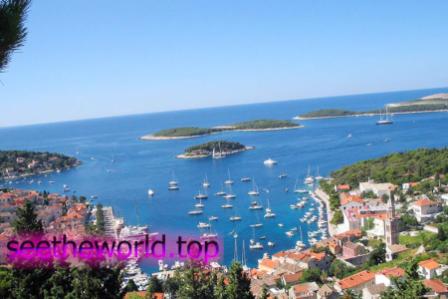
In addition, it is here on the Peljesac peninsula that the best oysters in Dalmatia are grown, the most famous Croatian wines – “Dingac”, “Postup” and “Malvazia” – are produced, and very tasty cheese is made.
The oldest synagogue in Europe has been preserved in Southern Dalmatia .
The main resorts of South Dalmatia
The main tourist spots of South Dalmatia are Cavtat, Mlini, Slano, the islands of the Lastovskogo archipelago and, of course, Dubrovnik: only in its vicinity there are more than a thousand architectural monuments, the fort of St. John houses the Oceanarium and the Museum of the Sea. Cavtat is famous for the Great annual festival, when creative groups perform in the village and its suburbs, and clowns and magicians walk the streets. The islands of Korčula, Listiv and Mljet are interesting for their bays, grottoes and protected underwater areas – a paradise for divers, all kinds of competitions and festivals are held almost constantly on the island of Solta. You can move between settlements on boats and boats, which is one of the favorite pastimes of vacationers. Special programs and routes have been prepared for fishermen at the resort.
The city of Dubrovnik in Southern Dalmatia

This city belongs to the European monuments of the Renaissance period and is among the most beautiful cities in Europe. It is located on the Adriatic coast and is a major port of the country. Its history spans several centuries and is full of interesting events.
The city has an international airport, so getting to it is not difficult. You can get from Kyiv to Dubrovnik for about 3 thousand hryvnias. You can get from the airport to the city center either by bus, for 130 hryvnias, or by taxi, which will cost about 900 hryvnias.
There are a lot of hotel establishments in Dubrovnik for tourists of different wealth. A simple guest house will cost two tourists approximately 1.5 thousand hryvnias per day. Rest in three-star apartments will cost two travelers approximately 2.3 thousand hryvnias per day. For those who want and can afford luxurious accommodation, there are five-star hotels, a double room in such a hotel will cost approximately 8 thousand hryvnias per day.
Beaches of Dubrovnik
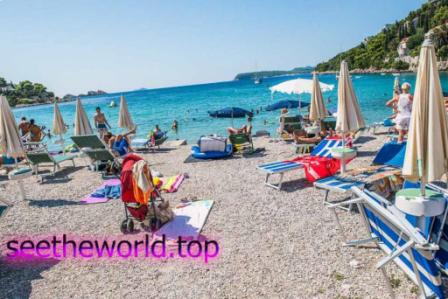
Almost all beaches are free. Most of them are beaches on platforms or covered with small pebbles. All of them are distinguished by clean water and good infrastructure. The following beaches can be noted:
Bathhouse . One of the few paid beaches, the surface is pebbles. Conveniently located in the center of the resort, there are always many vacationers here. The infrastructure is at a height, for entertainment – beach ball games, bananas, water skis, scooters.
Copacabana . The surface is pebbles, but the entrance to the water is gentle, and if you swim a little further from the shore, you will be walking on the sand, all this attracts those who are vacationing with families with children. The beach is free, but there are many pleasures for money: sunbeds and umbrellas, showers, for entertainment – boats, bananas, parachutes.
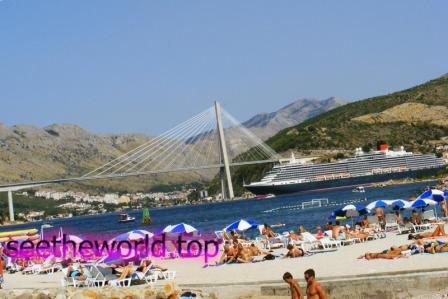
Lapad . It differs in that there is a small strip of sand near the entrance to the water. The infrastructure is decent: sunbeds, umbrellas, showers. Nearby there is a diving school, as well as the opportunity to ride various types of water transport.
Lokrum . The beach on the island of the same name, which should be visited exclusively by nudists. There is very beautiful nature and excellent infrastructure here, but sunbathing and swimming here will be comfortable only for those who are not embarrassed by human nudity.
Sights and entertainment in Dubrovnik
Initially, the city was founded on a small island, not far from the coast. Then it was connected to the land by filling a small channel with earth. Now there is Stradun Street , which is pedestrianized. Fountains and bell towers are installed at both ends of the street. If you came to enjoy a beach holiday, you should also take a walk around the city – start right here.
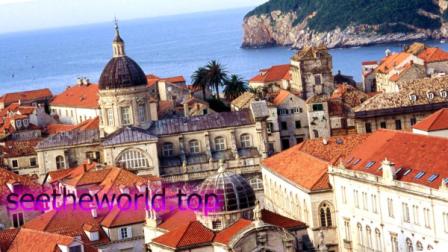
There are many historical and religious monuments in Dubrovnik. These include numerous museums, palaces and cathedrals, as well as beautiful fountains.
One of the preserved monuments of Dubrovnik is the city wall, built in the 16th century. In the 14th century, Franciscan monks founded their monastery here. Now only the southern part is left of it, which is a wonderful example of the architecture of that time. Be sure to visit the Cathedral of the Ascension of the Virgin Mary on vacation in 2018 , which houses the painting “The Ascension” by the famous Titian.
Families with children should visit the Dubrovnik Aquarium , the Maritime Museum and the Sveta Ana adrenaline park . Nightlife lovers should check out Bourbon Street . It is almost completely filled with bars. There are Cuban-style bars, places for rock lovers, as well as those with a more relaxed atmosphere.
There are also several discotheques in the city, among them there are simple ones like Esperanza , while Divinae Follie is distinguished by very loud music . The Lazareti disco is intended exclusively for young people under 25 years of age, and the Latino Club is suitable for tourists of any age.
The city of Cavtat in South Dalmatia
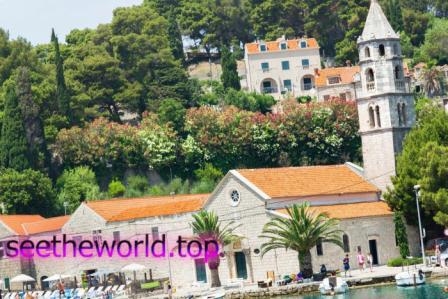
Cavtat, located 20 kilometers from Dubrovnik, is one of the most famous resorts in Croatia. This picturesque town is located on two peninsulas. Here you will meet complete harmony and unity with the world. A leisurely contemplative rest is facilitated by the wonderful nature, gentle lazy waves, and picturesque rocks. Such a rest in 2018 will bring health to your body and peace of mind.
You can get to Cavtat from Dubrovnik by bus for 6 euros, by tourist boat for 12 euros or by taxi for 40 euros.
This city is developing as a tourist center, so there is a very developed network of excellent hotels that offer guests excellent service at the level of international class. Two tourists can stay in a guest house for approximately 1.2 thousand hryvnias per day. A three-star villa will cost two travelers around 2,000 hryvnias per day. Well, for five-star comfort, you will have to pay about 7 thousand hryvnias per day for a double room.
Beaches and water sports in Cavtat
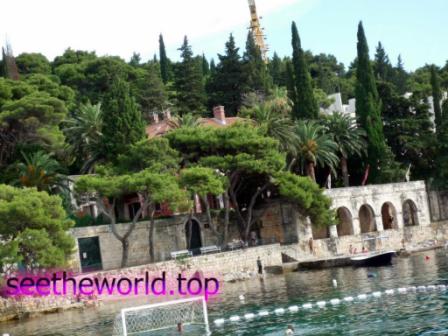
In Cavtat there are pebbly beaches typical for Croatia, but there are also those covered with sand, which is considered a rarity for the country. Surrounded by pines and cypresses, the beaches of Cavtat have been awarded the Blue Flag for their environmental friendliness and cleanliness. Each beach has numerous water activities. Here you can rent equipment for diving, rent a yacht for a walk or just go banana boating or water skiing.
Sights and entertainment of Cavtat
The city has a rich history and has beautifully preserved its heritage. In the architecture of the city, features of various styles and all historical eras can be traced. The most vivid and interesting buildings belong to the era of the Dubrovnik Republic . They combined Gothic and Renaissance features.
One of the most beautiful buildings is the Prince’s Palace , located on the embankment. Now there is a museum in it, which offers to admire the exposition of ancient objects. In addition, this building houses a library of unique historical documents.
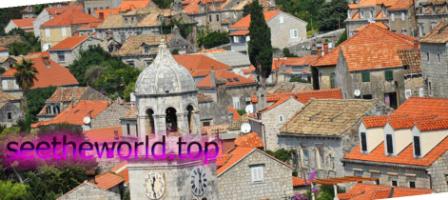
From the church architecture, it is definitely worth noting the monastery of the Virgin Mary of the Snows . It was built in the 15th century and is located at the foot of a picturesque mountain. Not only the building itself is beautiful, but also what is inside: priceless works of masters of the 16th century. The Church of St. Nicholas is a building that combines Baroque and Renaissance features. Inside the temple there are stunning icons of the work of creators of the 15th century. In addition, there is a museum attached to the church, where you can see objects of worship, ceramics, sculpture, painting.
A more modern landmark is the mausoleum of the Racich family . It was built at the beginning of the 20th century. The white stone building is decorated with sculptures and makes you think about the eternal.
The town of Mlyny in Southern Dalmatia
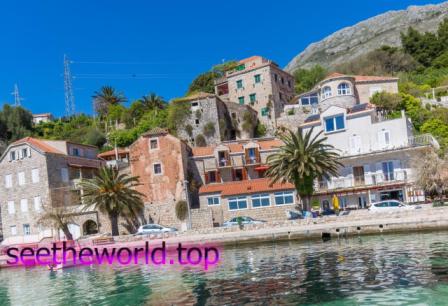
Mlini is a small resort town 10 kilometers from Dubrovnik. You can get there in half an hour by bus. Accommodation in Mlyny for two tourists will cost from 2 thousand hryvnias per day, the town has both hotels and the private housing sector.
A vacation in Mlyny will bring only pleasure to vacationers: local residents are very friendly to vacationers, anyone will tell you where you can eat inexpensively and deliciously or which excursion to go on. The beaches of the town are covered with small pebbles.
The settlement itself is ancient – it has existed since the 14th century. However, since the town is small, there are not many sights here: these are the churches of the Holy Spirit, the Holy Rock, the Holy Hilarius, as well as the ruins of a Roman settlement. Therefore, mostly tourists here simply bask in the sun, swim, and walk along cozy streets. Be sure to buy a silk-embroidered product – local craftsmen have been making them well for several centuries.
The city of Plat in Southern Dalmatia
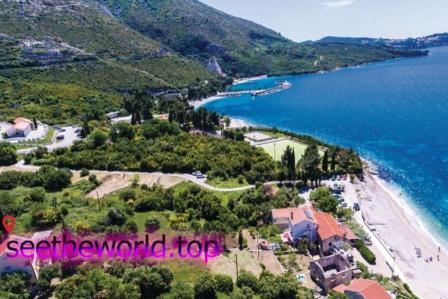
Plat is located a little further from Dubrovnik, 12 kilometers away. The same half-hour bus ride connects it with the largest resort in South Dalmatia . Of the hotel facilities, the private sector is represented mainly, accommodation will cost two tourists approximately the same 1.2 thousand hryvnias per day.
The beaches of the city are also covered with small pebbles. A distinctive feature is a good infrastructure, as well as a large number of entertainment: diving, water skiing, beach games with a ball, a large number of children’s playgrounds.
There are no attractions as such here: Plat is exclusively a resort town, however, the night life here is not raging either. And therefore, for recreation, Plat should be chosen by those who want solitude in nature, or by those who are ready to go for entertainment by transport.
The island of Korčula in South Dalmatia
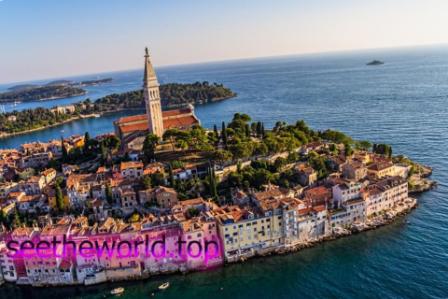
Korčula is a fairly large island for the Adriatic, its area is about 236 square meters. km
The island is almost completely covered with hundred-year-old pines and vegetation that grows in the Mediterranean. The coast of the island is dotted with cozy bays. There are pebble and sandy beaches. The island is blown by sea winds, which create ideal conditions for lovers of water sports and soften the hot summer.
One of the main attractions of the island – the birthplace of the great traveler Marco Polo – the house-museum of the same name.
Kolochep Island in Southern Dalmatia
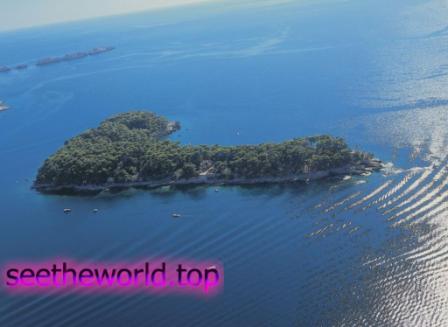
The island is located 11 km from Dubrovnik, you can get there in 30 minutes by ferry.
On the island, with an area of about 2.5 square meters. km and the coastline is 13 km, there is absolutely no car traffic, and therefore the air here is not just clean, but impeccably clean. Lobsters live in the clear waters surrounding the island.
On the island of Kolochep, there are two small villages located three kilometers from each other, on opposite sides of the island, among pine groves and vineyards, cypresses and citrus groves. The beaches here are pebbly and sandy and rocky natural platforms.
Among the sights of the island are ancient architectural monuments dating back to ancient times and the Middle Ages.
The island of Mljet in South Dalmatia
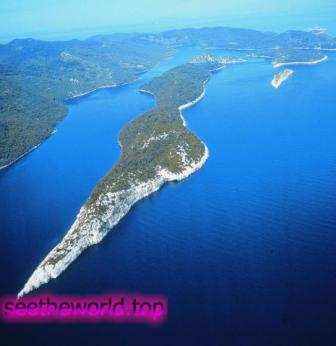
You can get to the island from Dubrovnik by ferry – it will take about 1.5 hours.
The hotel infrastructure is represented mainly by the private sector: the price tag starts at approximately 1.5 thousand hryvnias per day for two people.
In fact, most of the territory of this picturesque place is occupied by a nature reserve. In it you can admire two salt lakes, on the shores of which many birds and animals live, there are also caves on the island. Among the architectural beauties is the island of St. Mary , located in the middle of one of the lakes, on which stands the Benedictine monastery of the 12th century.
Mljet is perfect for all sports people. Kayaking, surfing, fishing … divers will also like it here, because the surroundings of the island hide many sunken ships – but diving is better only for professionals.

Another feature of the island is that it has sandy beaches, and as is already obvious, this is rather an exception in South Dalmatia . If you stay in the village of Saplunara, you will be able to enjoy a beach vacation to the fullest: the waters are clean, the entrance to the sea is gentle, the bay protects this place from the wind, and the pine trees provide blessed shade. By the way, you can swim in the lakes of the reserve.
Kitchen and shopping
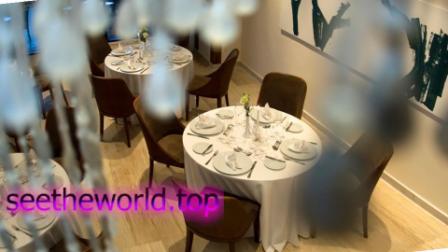
There are many different cafes and restaurants in all the resort towns of South Dalmatia . Located in large settlements, they will gladly offer their customers a wide variety of dishes, including European and Asian cuisine. But if you came to Croatia on vacation, we advise you to try the local cuisine. Meat dishes, for example, smoked pork bone or grilled lamb, will be especially unforgettable. They also like seafood here – oyster soup or eels. Don’t forget to try several varieties of local cheeses, especially farm sheep. For a snack, take vegetables with olive oil. The cuisine of Southern Dalmatia will also delight those with a sweet tooth: quince or grape marmalade, figs, caramelized almonds are loved here.

Famous wines of the region are considered to be:
Dingach . Tart red wine with a strong aroma of berries and a hint of oak, which leaves a pleasant aftertaste.
Malvasia . White wine, refreshing in the heat, rich in variety: notes of fennel, quince, honey.
Progress . Premium quality red wine with high strength.
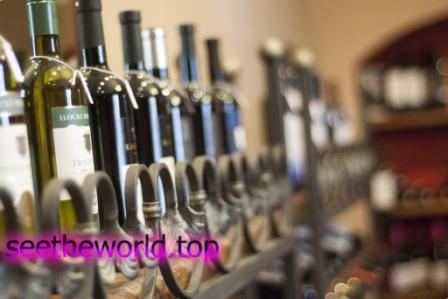
What to bring with you from South Dalmatia as a souvenir and as a gift? First of all, these are edible souvenirs: the same wines, sausages, and cheeses.
Want something more colorful? You can buy herbal tincture. Lovers of aromas are happy to buy local fragrant lavender.
In addition to these things, linen products and lace are brought from here. There are also “all-Croatian souvenirs”: a silk tie, a feather pen, jewelry in the “morčić” style. And as numerous small gifts for relatives or colleagues, you can buy small dolls in national clothes or miniature copies of amphorae.
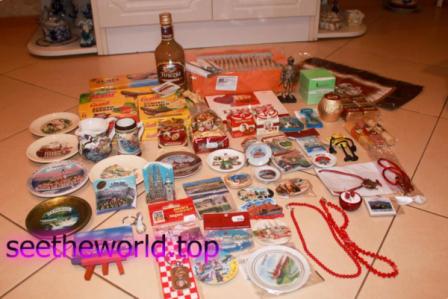
Southern Dalmatia is the pearl of Croatia. It combines the riot of colors of nature, ancient architecture, and the opportunity to relax both in a large metropolis and in a small village. In general, even a sandy beach can be found, and the large number of water activities is simply stunning. The local population is friendly, the situation in the region is safe. In addition, recreation in Croatia is far from the most expensive among European countries, and in terms of quality, it is no worse. Therefore, be sure to go to Southern Dalmatia in 2018 – and the summer will be wonderful!
Entertainment and sights of Southern Dalmatia
Most of the historical monuments are concentrated in Dubrovnik. This city is a monument of the European Renaissance and is one of the most beautiful in Europe. It is in Dubrovnik that the oldest synagogue in the Old World is located, as well as the city wall built in the 16th century. and the Franciscan monastery of the 14th century. (though not completely), as well as the cathedral, which houses a very valuable relic – the painting “The Ascension” by Titian.
Nightlife is also concentrated in Dubrovnik. The rest of the resorts are more relaxed, although restaurants and bars are, of course, everywhere. The main party place in Dubrovnik is Bourbon Street . It is almost completely filled with bars and discos for every taste: there are Cuban and rock bars, young people prefer Lazareti , and for those who like and know how to dance salsa and bachata, the Latino club works .

In Cavtat, you should visit the Prince’s Palace and be sure to visit the library of historical documents, as well as the Church of St. Nicholas , the Rachic Mausoleum, and the Monastery of the Virgin Mary . Sightseeing tours can be combined with rest on a pebble beach.
All beach resorts have rental equipment for water activities. The island of Korcula, which is known for its excellent waves, also has surf instructors.
Seafood lovers will be interested in visiting the Pelešac peninsula : see how oysters and mussels are grown, and then taste them in any of the numerous coastal restaurants.
Sights of Southern Dalmatia
Old town and fortress walls of Dubrovnik
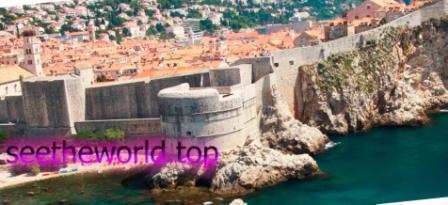
The fortress walls of Dubrovnik are a complex structure and the most important local attraction, from the height of which a unique panorama of the entire city opens. The walls encircle the entire Dubrovnik and are still a powerful defensive and defensive fortification. The total length of the object is about 1940 km.
You can get to the fortress wall through the Old Town, with an entrance ticket through the Ploče and Pilje city gates. Walking along the walls, it is worth taking a look at the famous towers, fortresses and casemates built in the 9th-12th centuries. The most famous of them are the Ravelin fortress, the Minchet tower, and the Lovrienac fortress.
The Old Town is the historical area of Dubrovnik, which is considered a unique architectural object. You can get here only through the city gates, which are open from 8:00 a.m. to 6:00 p.m. Most of the local houses are up to 500 years old, and this is not the limit for such an ancient place as Dubrovnik.
Visitors to the Old Town can enjoy walking through the medieval streets, as well as relax in numerous street cafes. Historical objects can be found everywhere in the Old Town, but in order not to miss them (and not to get lost), it is better to have a map with you.
Cable car to Dubrovnik

The Dubrovnik cable car was built back in 1969, but 20 years later it was completely destroyed during the war and restored only in 2010. Now the road is one of the most notable tourist attractions. The funicular offers a breathtaking view of the Dinaric Highlands, the entire Old Town and the sea coast. The uniqueness of the road lies in the fact that it is the only similar object on the entire Adriatic coast.
The descent starts from Mount Orge and, thanks to modern equipment, takes no more than 4 minutes (6.5 meters per second). At the disposal of tourists are 2 glass funiculars that ply along the road from 9:00 a.m. to 8:00 p.m. (and in summer until 12:00 a.m.).
Departure is every half hour and always from below (northern part of the city wall, Ploče station). One funicular can accommodate about 30 people and rises to a height of 405 meters, covering a distance of 778 m. In addition, you can explore the surrounding area from the top of the mountain – there are comfortable panoramic terraces, a restaurant and a cafe (places can be reserved in advance). On the mountain, you can take a look at the souvenir shop, the amphitheater and the Civil War Museum dedicated to the war in Croatia 1991-1995. Orj is simply the best place to meet, for example, the sunset.
Gate of Pillai
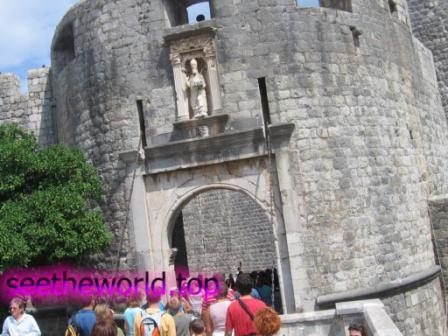
The entrance to the western part of the Old Town (lapada) is made through the city stone gate of Pilje (Greek: “Gate”) and a direct acquaintance with Dubrovnik begins. For many years, Pilje was used as the main entrance to the city, but now it is one of the main historical and architectural monuments of Dubrovnik. Interestingly, Pila is the partial remains of the old Pila fort, which stood on this site until the beginning of the 19th century. The building itself was demolished, but its gate remained. Semicircular external vaults were added to them, which turned into one of the main attractions of the city.
If the outer gate is built in the spirit of the Renaissance, then the inner one (in masonry) is in the style of mature Gothic. It was this arched gate that finally replaced the remains of the Pila fort.
Above the ancient entrance, in a small niche, there is a statue of the patron saint of the city, Vlasius (Vlach) Sevastskyi, by Ivan Mesterovich, and a three-arched stone bridge leads to the gate, which was installed on the site of the former wooden one.
The city gates of Pilje are ceremonial and can hypothetically be locked. The key to them is kept in the Prince’s Palace of the city. Visitors are admitted for a small fee.
Lovrienac Fortress
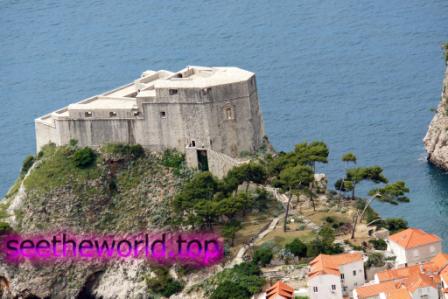
According to historical chronicles, the Lovrienac fortress (also known as Fort St. Lawrence or “Gibraltar of Dubrovnik” ) was built in just 3 months by unruly residents of Dubrovnik who did not want to be under the rule of Venice. Above the gate of the fort there is still a proud inscription: – “freedom is not sold for all the treasures of the world.” The fortress still has a threatening appearance, although it has long ceased to fulfill its defensive functions. The fortification was built on an isolated steep rocky peninsula in the eastern part of the city, outside its city wall at an altitude of 37 m above sea level.
Today, the Lovrienac fortress is part of the city wall and is the largest medieval defensive structure. This triangular structure has several terraces of different levels and two suspension bridges. The thickness of the outer walls is about 12 meters, and the inner walls are only 60 cm.
It is noteworthy that in addition to the military function, the fortress also has cultural value. Excursions are often held here and there is a theater in which festivals, concerts, and theatrical productions are held. One of the most spectacular in the local entourage is probably the production of “Hamlet”.
The old town of Korčula
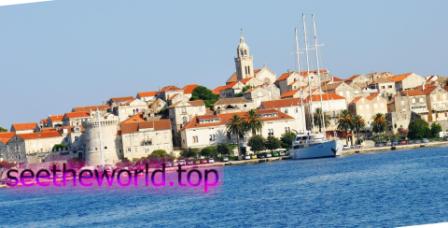
As in any other historical place in Croatia, Korčula also has its own Old Town. This is a kind of historical center of the city, its pearl, where most of the best monuments of architecture, culture and art are located. The old town is the main place of pilgrimage for city guests and tourists who come here to get to know the local sights.
Geographically, the Old Town is located in the north of Korčula, and its landmark is St. Mark’s Square .
Like the whole of Croatia, the city was ruled at different times by representatives of different peoples, whose preferences and habits also affected the appearance of the city. The most famous architectural monuments of the Old City are buildings in the Renaissance style. Most of them bear the emblems of the city, and the main part of the buildings is decorated with traditional stone carvings.
Like the rest of the city, its old part reflects the basic form conceived by the city’s founders. Since Korčula should architecturally resemble the shape of a fish, the buildings and streets in it have certain outlines and decorations. The old city, in particular, is located in the “tail” of this fish, and its shape resembles a regular circle surrounded by a fortress wall.
Cathedral of the Assumption of the Virgin Mary in Dubrovnik
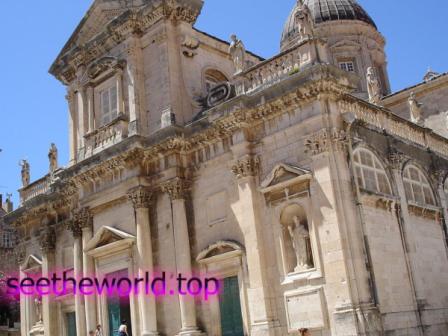
The Cathedral of the Ascension of the Virgin Mary is an active Catholic church belonging to the Diocese of Dubrovnik. The cathedral is a historical and cultural monument of the Baroque era, and was built on the site of a medieval church by Andrea Bufalino .
The construction work lasted for about 30 years, during which there were also changes in the architect-developers who made changes to the original Bufalino project. In general, the style of the cathedral is based on elements of the Italian Baroque, it is made in the traditional form of a cross, has a large dome, three naves and three apses. The facade of the temple is decorated with grand staircase, columns and richly decorated stucco.
Inside you can see the grandiose marble altar of Ivan Nepomuk , and on the main altar of the cathedral there is a polyptych ” Ascension of the Virgin Mary ” by Titian . The relics of the patron saint of the city – St. Vlasius – are stored here, encased in a golden coffin of the XI century. The most valuable objects of religious art (more than 200 objects) are stored in the treasury of the cathedral.
It is interesting that you can get into the treasury only if you have three keys to the sacristy in which they are kept. Apparently, only thanks to such tricks, the contents of the rich collection are still in absolute safety.
Lodge Square
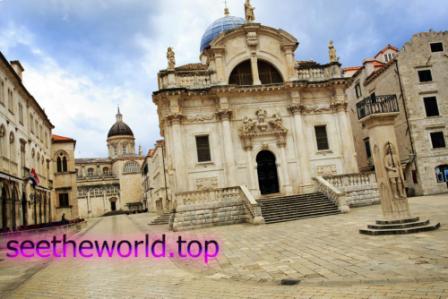
The Lodge Square is located in the northeast of the Old Town and is its main vital artery. The main flow of local residents and tourists passes here, and the main historical monuments (buildings, monuments) of Dubrovnik are located here.
In the very center of the square stands a column dedicated to the defender of the city – the valiant knight Orlando . The work was created in the Middle Ages by the sculptor Antonio Raguzina . Immediately behind the column, you can see the church facade in the baroque style – it belongs to the church of St. Vlasius . In the church altar is a unique work of Croatian jewelers – a silver statue of St. Blaise , covered with gilding.
The square also features a signal tower (31 m high) – an ancient belfry with a clock (15th century), the building of the City Guard and a small Onofrio della Cava fountain (in a wall niche). The ancient buildings located on the Lodge Square are not only architectural monuments, but also active administrative premises. For example, in the old town hall, which was created in the spirit of neo-Gothic, there is a city hall, as well as a cafe and a theater.
Loža Square is the heart of Dubrovnik and one of the most popular places in the city due to its convenient location.
House of Marco Polo
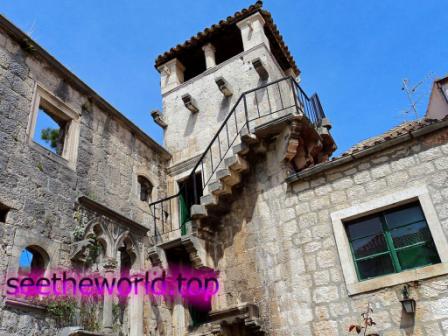
In the heart of the Old Town of Korčula, to the north of the Church of St. Mark, there is an ancient stone house. It has long belonged to the Polo family and it is believed that the famous explorer, traveler and writer Marco Polo was born here (although the people of Italy are sure that Polo is their compatriot).
For a long time, the building was under the protection of the city, it was reconstructed several times, and then the Marco Polo Museum was organized in the building . Guides introduce visitors to costumed wax figures of former residents of the building, as well as the life and activities of a famous compatriot.
Marco Polo is famous for his book Il Milione, which was written in 1298, the year Polo was captured in a sea battle between Genoa and Venice, which took place near Korčula. Taken to the Genoese prison, Polo began to write down the stories of his adventures and travels in Asia. Il Milione soon became a translated and widely read book after the Bible and the Koran. And it was this book that inspired Christopher Columbus to travel to the New World.
The Marco Polo House-Museum is open until the middle of the day and receives a large number of tourists every day, introducing them to the history of 700 years ago.
Minchet Tower
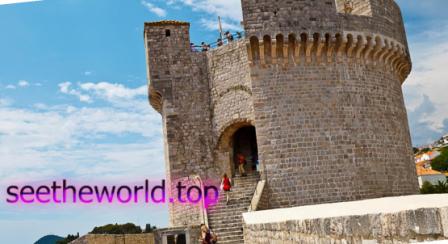
Minceta Tower is the most famous point of defense and a kind of symbol of Dubrovnik. At the same time, the tower is also the highest point of the northern fortress. The name of the attraction (and the fortress as a whole) comes from the surname of Minchet aristocrats , who donated their land to the city for the construction of a defensive structure.
The fortress was built in two stages. Initially (in the 14th century), the tower was square in shape, its project was created by the local architect Nikifor Ranzhina . Reconstruction was carried out 100 years later, in connection with the attacks of the Turks and in accordance with new ways of fighting. The Italian architect Michelozzo di Bartolomeo proposed to build a sloping rounded bulwark with gun holes and walls 6 feet thick.
The height of the tower and its appearance were adjusted once again by the architect Yurii Dalmatynets , this was done after the capture of Bosnia by the Turks . The construction was completely completed by 1464.
The object really turned out to be indestructible – there are two viewing platforms, a strong base, thick walls and a rounded shape with teeth and consoles. The tower itself rises above the fortress and the northwest of Dubrovnik, opening an excellent panorama of both the mountains and the sea.
Franciscan monastery in Dubrovnik
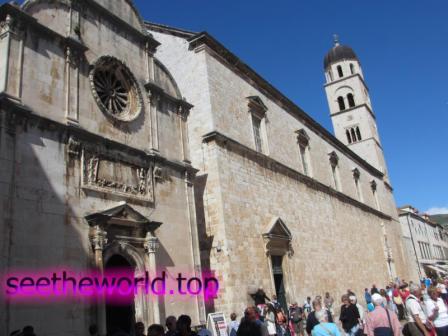
The Franciscan Monastery is a huge temple complex in Dubrovnik, located to the left of the Pilje Gate, at the beginning of Stradun Street in the Old Town. The building was built for a very long time, starting from the 14th century. For several centuries, it was repeatedly destroyed during wars and natural disasters.
The earthquake of 1667 destroyed the building almost completely, only the southern portal was spared. The restoration of the monastery, like other historical objects of the city, took place in the 17th century. In general, the building is recreated in the Baroque style, but elements of Gothic and Renaissance architecture are also clearly present in the image of the renewed monastery.
An attentive visitor will find at the entrance a sculpture of St. Jerome and St. John the Baptist , and directly above them is a statue of God the Creator .
The entrance for tourists is not open to all premises, but the monastery pharmacy, which was founded in 1317, continues to work to this day, and accepts all sufferers every day. Also, the monastery has a library with a rich collection of books, including ancient manuscripts, and there is a large exhibition hall where ancient paintings, jewelry and historical rarities are placed.
Stradun Street in Dubrovnik
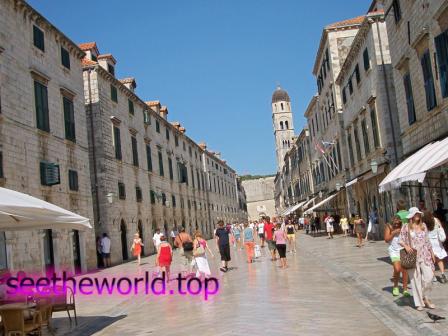
Stradun Square is the famous pedestrian zone of the Old Town of Dubrovnik, an analogue of Moscow’s Arbat and the main street of the historic city center. The street connects the western and eastern parts of Dubrovnik, stretching from the city gate Pilje to the gate Ploce.
Stradun became the main street around the 12th century, but its modern appearance was formed only at the end of the 17th century, when the city was rebuilt after an earthquake. In ancient times, the 300 meters of the limestone-paved street was the main commercial life, which is still visible today – all along the Stradun there are benches and small shops on the first floors of buildings, and sales, according to the old custom, are conducted through the counter on the windowsill.
Today, the houses here are made in a uniform style, with frequent arcades and sophisticated carved decorations. The doors and windows are arched, almost all buildings have three floors, and the kitchens, to avoid fire, are located at the very top, in special rooms – lofts.
Stradun is also famous for the fact that on holidays folk festivities and concerts are held here. For example, at the beginning of February, a traditional procession in honor of St. Blaise takes place here, and in December, New Year’s Eve is celebrated with grandeur.
Prince’s Palace in Dubrovnik
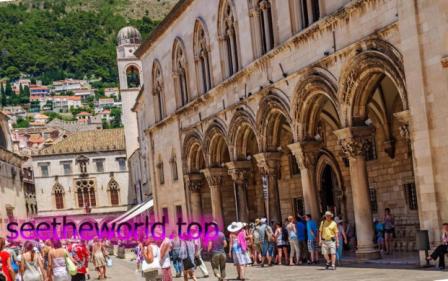
The Princely Palace (also known as the Rector’s Palace) in Dubrovnik dates back to the 15th century. During this time, it was repeatedly destroyed by earthquakes and rebuilt in accordance with the architectural advantages of the corresponding era. Therefore, the appearance of the palace is a mixture of Gothic, Renaissance elements, Baroque style with pronounced Venetian features. It is noteworthy that many details have been preserved intact until now and represent the greatest historical and cultural value.
The palace is called “princely” not because it belongs to one specific owner, but as the place of residence of a person who is in power at one time or another.
Today, the palace is a one-story building with a small courtyard formed by 4 wings of the building, and two galleries. The Prince’s Palace is a historical-architectural monument and a museum. There are collections related to the history of the city (original furniture, documents, paintings, coins, city keys, etc.).
In addition to its historical role, the Prince’s Palace continues to perform secular functions – city celebrations, holidays, festivals and classical music concerts are often held here.
Chilipi village
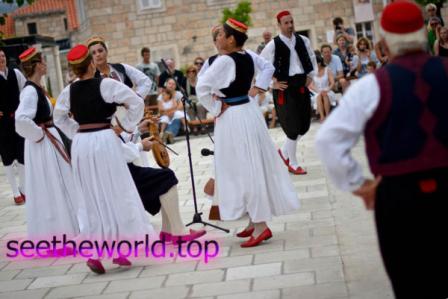
The village of Chilipi is a small town on the Adriatic coast known for its ancient stone architecture. Administratively, the village belongs to the Konavle region and the Dubrovnik-Neretva district , but is closer to Cavtat (only 5 km).-
Chilipi is even more popular thanks to the respectful attitude towards folk rites: here they are traditionally performed festively, with the use of national costumes, accompanied by songs and dances.
For 40 years now, every Sunday from Easter until the October frosts, similar performances can be seen on the main square of the village in front of the parish church of St. Nicholas .
A holiday in Chilipa is an opportunity to spend time in a quiet and cozy rural environment, visiting local beaches and attractions, and being in close proximity to major highways. Here you can try home-made wine at an organized tasting, buy souvenirs in stalls, attend a church mass and admire colorful folklore performances.
The village of Čilipi is also known for its proximity to the Dubrovnik airport: in fact, this is where most of the passers-by stop on their way to the plane or to Cavtat.
Museum of icons
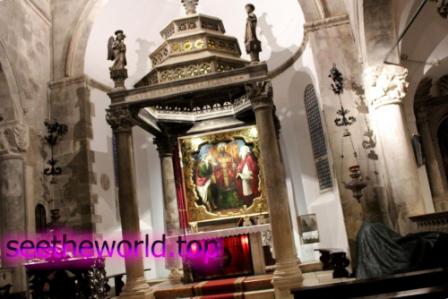
The Museum of Korčula Icons was created with the help of the city’s merchants and sailors, who brought interesting specimens from their travels. The museum building is located on the street. Kaporova, opposite the Church of All Saints and attracts church pilgrims and tourists who are interested in religious art as visitors.
The expositions of the museum represent the iconography of different eras (13th-18th centuries) and in different versions. There are both originals and copies of famous icons. Many works are made on wood, gold plates, canvas, etc. Most of the icons were acquired by the museum or received as a gift from patrons and ordinary donors.
On the walls of the museum there is, in particular, a wonderful collection of icons from the Greek island of Crete. History shows that they appeared in the city during the war between Venice and Turkey in 1645-1669. The inhabitants of Korčula also took part in the battles that took place on the island of Crete. And when the war ended with the defeat of the Venetians, there was a general evacuation of the Venetian garrison, administration and clergy to Korčula. Along with the galleon, interesting icons, created on the basis of Byzantine traditions and under the influence of the Venetian painting schools of the XIV-XVII centuries, arrived.
Bishop’s Palace
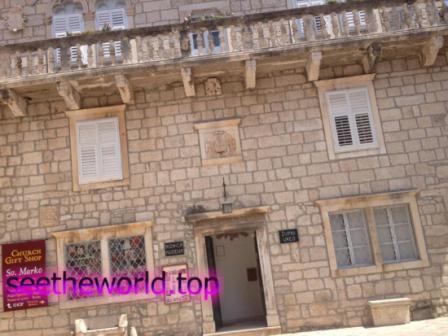
The Bishop’s Palace or the Episcopal Treasury, built in the XIV-XVII centuries, is located next to St. Mark’s Cathedral . Abbot Ivo Matias allocated the money for the construction , and the Croatian artist Ljubo Babich was engaged in the design . Unfortunately, the building was not preserved in its original form, because it was reconstructed at the end of the 19th century.
Today it is a beautiful Gothic building with open arched halls on the first floor where visitors can learn about medieval life and everyday life. In the glazed cabinets and showcases of the palace, rare icons and drawings from the Renaissance and Baroque eras are presented, as well as numerous documents and books that tell about the history of Korčula and Croatia as a whole. Among them are quite rare editions such as the ” Code of Korčula ” from 1214. Visitors will also be interested in halls with paintings of the XV-XVI centuries, collections of sculptures and a numismatic collection with quite rare coins.
The most interesting and important work of the palace is the polyptych “Madonna with the Child and Saints” by the artist Blaise George from Trogir , dated 1431. Contemporary art is also present in the exposition, mainly paintings on religious themes.
Monastery of the Virgin Mary of the Snows
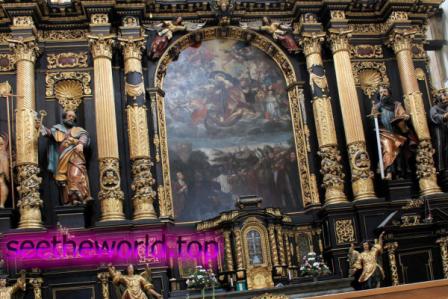
The Monastery of the Virgin Mary of the Snows was founded in Cavtat at the end of the 15th century on the initiative of the small brotherhood of Dubrovnik. The name of the monastery comes from the Christian legend about the snow that suddenly fell in Rome on a hot August day after the apparition of the Mother of God.
The construction was carried out in two stages: first with the funds of the Franciscans, and then (in the 16th century) with a donation from the nobleman Frank Gucetich . The church at the monastery was built a little earlier and was already functioning by the time the monastery was built.
The monastery complex is a small rectangular building with a church in the eastern wing and a garden in the northern wing. Unfortunately, after the earthquake of the 17th century. only part of the original building remains. The building was renovated and restored several times: at the end of the 19th century. a belfry was erected here, and an organ was installed, as well as updated church equipment and ministers’ clothing.
The modern Gothic tower of the monastery, which can be seen from the shore, was built at the beginning of the 20th century. The interior decoration, in particular, gilding and decoration of pulpits, was done at the expense of local residents.
Today, art exhibitions are often held in the monastery, and the church as a whole was registered as a cultural monument in 1984.
Dubrovnik market
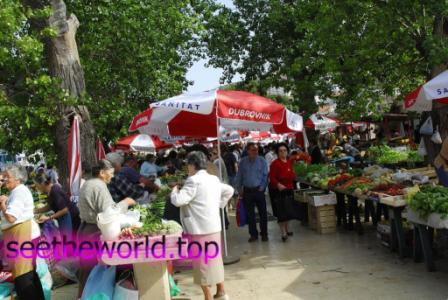
The Dubrovnik market is located in the town of Gruz , next to the seaport of Dubrovnik and is popularly called Gruž Market (after the name of the port and suburb “Gruž”). The port lies in a deep sheltered bay that can accommodate both cruise liners and ferries.
The market is located 2 km from the Old Town (next to the Libertas bus station ) and has the lowest prices in the city. Local delicacies, fresh seafood, fruits and vegetables, sweets and homemade wine are sold here.
Visiting the Dubrovnik market is recommended for those who want to save money, those who appreciate the busy market life and those who like to bargain. You can get here after numerous excursions around the Old Town or simply by taking the 1-B or 1-A connecting bus. The market is open from 6 am to 8 pm (summer) or until 6 pm in other seasons.
In addition to buying products in the market area, you can have a great lunch in port taverns and street cafes, where naturally the main dishes are fish and seafood delicacies.
The local architecture perfectly fits and complements the image of the market, making it even more colorful and attractive. Solid green areas prevent the summer heat from harming those walking, and the sea breeze makes visiting the market even more romantic.
Lokrum and the Dead Sea
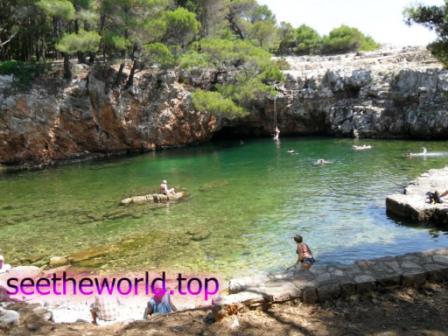
Lokrum Island is a protected place in Croatia and a popular tourist attraction. The island got its name from the distorted Latin “acrumen” – that was the name of the citrus fruits that were grown on the island by Benedictine monks. Lokrum is located in the waters of the Adriatic Sea, directly opposite Dubrovnik. In the summer season, you can get to the island from the pier in 15 minutes by cruise ship. At other times, there are also connections approximately once an hour.
It is interesting that there is practically no infrastructure on the island, and rare cafes close quite early. When arriving here, it is necessary to carefully monitor the time, because the last ferry leaves for the city around 5 pm. If you miss it, you will have to spend the night under the starry sky until morning.
In addition to several historical buildings ( Fort Royal or the botanical garden of Maximilian Habsburg ), Lokrum has its own small lake called the Dead. This is a rather small and salty reservoir connected to the sea. As fate would have it, the lake became the home of local peacocks, which are allowed to be hand-fed. The bottom of the lake is strewn with pebbles, and special ladders lead from the rocky beaches to the descent into the water. Families with children and unskilled swimmers like to relax on the lake – the salty water holds both children and adults equally well.
Dominican monastery
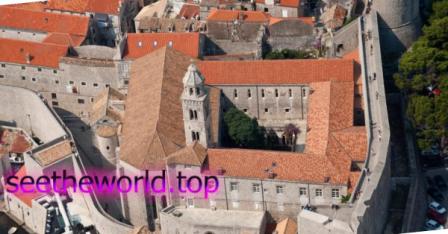
The Dominican monastery, which is the decoration of the eastern part of Dubrovnik, was built on donations from the townspeople in the period between the 13th century. and XVI century. (times of the republican past of the city). In addition to the aesthetic role, the monastery also plays a defensive function, being part of the ensemble of the city fortification and the Revelin fortress .
Since the building was built for more than 200 years, it has a unique appearance: the mastery and skills of Croatian and Italian builders from several eras were superimposed on the original design of the architect. The appearance of the monastery perfectly demonstrates various architectural styles and directions – from Baroque to Renaissance and Gothic. Such a mixture of styles does not harm the complex at all, but makes it even more harmonious and sophisticated.
The appearance of the monastery is quite laconic from the outside, which is compensated by the rich interior decoration and furnishings.
A popular historical monument is the Dominican monastery and the unique collection of paintings housed in the local museum. The canvases belong to the period of the XIV-XX centuries. and are mainly devoted to a religious theme.
There are also ancient church books – incunabula, many ancient manuscripts and manuscripts.
Don Cholo

Done Cholo is a small coastal village on the northwestern coast of Kolochepa , which stretches along the shores of a beautiful sandy bay. Despite the fact that the island is far from the main tourist routes, the majority of vacationers and residents of nearby cities want to get to Doni Cholo.
Visitors are attracted to the surrounding village by its wild nature and diversity of its rocky landscapes, beautiful beaches and the cleanest water of the Adriatic, pine forests and multi-grass meadows of this area of Kolochep .
It is noteworthy that Kolochep itself and Done Cholo have always been attractive to vacationers. And in past centuries, the nobility preferred to rest in such secluded places – this is evidenced by the numerous ruins of aristocratic villas (15th century) covering the island.
From May to October, the village operates its own three-star hotel “Villa Kolochep” , in which those wishing to stay longer in Don Cholo can comfortably stay. You can also simply rent a room or apartment if you want to stay suddenly.
In general, Donei Cholo has everything you need for a civilized vacation: a convenient anchorage on the coast, a large berth for large ships, ferries and boats, a grocery store, beaches, bars and restaurants.
Gorne-Cholo

Gorne Čolo is the most favorite place of residents of Dubrovnik, Koločep and guests of the island, who come here on hot summer days on boats, yachts and pleasure boats. The village belongs to the Dubrovnik-Neretva district and is located in a beautiful bay of the eastern part of the island of Koločep , which can be seen from the windows of the villas located opposite Gorne Cholo.
The name of the village translates as “upper” and means a close position to the city. The main part of the territory of Gorne Cholo is covered with rocky hills, pine and myrtle forests, sandy and pebble beaches. The coast is especially appreciated by the guests of the village, about 12 hectares of which have been under protection since 1961.
Gorne Cholo is attractive for those who prefer ecotourism, like to rest in the wild nature and seek solitude. Life here flows in a Mediterranean style slowly and, according to the reviews of vacationers, it creates the impression of traveling in time.
Not so long ago, a modern pier was built in Gorne Cholo, and now it is convenient to come to the village from Dubrovnik and Koločep by boats and cruise ships. Previously, guests had to spend a lot of time on foot from Doni Cholo, where ships from the port of Gruz usually arrive.
Mausoleum of the Racich family
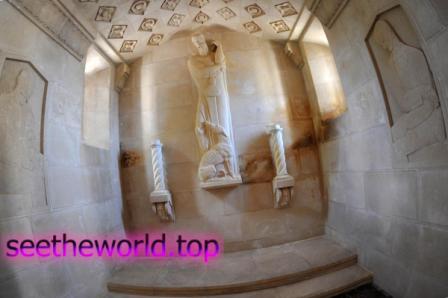
One of the most unique monuments of architecture and sculpture in Cavtat is the mausoleum of the Racich family, dedicated to the Queen of Angels. The well-known shipowners of Racich are buried in the city cemetery of St. Doli . The mausoleum itself was built in 1921 according to the will of the testator Maria Rachich on the site of the ancient church of St. Dola (15th century).
The building is made of white stone brought from the island of Brač and decorated in the form of a dome. Almost no other materials were used for finishing the building, except for the bronze coating of the doors, bells and angels.
The interior of the mausoleum is full of symbolic images of the three stages of human life: birth, life and death.
The room is decorated with stone faces of angels on the vault, symbols of the four evangelists on the floor, the main altar and side naves. The bell of the mausoleum was cast by a friend of the Racic family, the famous Croatian sculptor Ivan Meštrović , and there is an inscription on it: “Having understood the secret of love, one can know the secret of death and grasp the eternity of life.” The iconography of the mausoleum is also interesting from the point of view of the interpretation of Christianity, as it is full of the master’s personal attitude towards the Racich family.
The mausoleum of the Racic family was recognized by the international cultural community as one of the first works of Meshtrovych and an original combination of stone architecture and sculpture. In 1925, the monument was awarded the Grand Prix of the International Exhibition of Modern Industrial and Decorative Art (Paris).
Onofrio’s Fountain
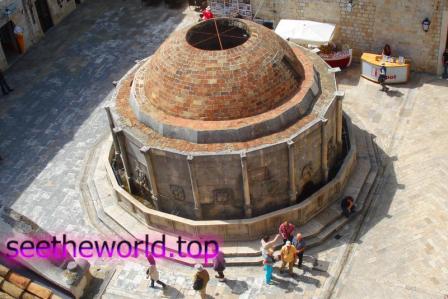
Onofrio’s Great Fountain is the oldest structure on the entire Adriatic coast. It was built in the 15th century as the end of the city’s aqueduct system, which stretched for 12 km. Before the appearance of the water supply network, fresh water was obtained by collecting rainwater in special tanks. Finding Onofrio’s fountains (both small and large) today is absolutely not difficult – they are located at different ends of Stradun Street.
The large fountain got its name from the name of the creator – the Italian architect Onofrio della Cava . The master created several more objects in Dubrovnik, but only one of them was named in his honor (although other sculptors and architects participated in the construction).
The Onofrio Fountain has an original appearance – it is a hemispherical building with a large dome, 16 faces and carved decorations. Water enters a bowl with 16 holes, through nozzles in the form of stone masks (mascarons) with different expressions on them. Unfortunately, some of the medallions were destroyed and still have not been restored.
It is noteworthy that nowadays water comes to the city from the same source in the mountains that was discovered a century ago. The water supply system, somewhat updated, is still in working order.
Archaeological Museum of Dubrovnik
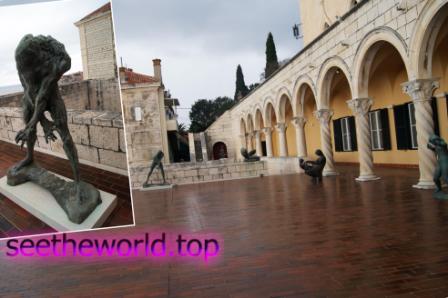
The history of the Archaeological Museum of Dubrovnik is extremely interesting. In 1872, it was organized under the name of the Patriotic Museum , the first exhibition of which was opened six months later. The exhibition mainly presented exhibits from the republican period, but it was also possible to see archaeological finds: an Egyptian mummy, Greek vases and ancient amphorae.
As archaeological science developed in Croatia (approximately from 1920), the museum was also filled. In 1932, the museum moved to the first floor of Fort St. John , and at the same time, the first permanent expositions based on archaeological finds began to open.
The Archaeological Museum received its modern name in 1990, becoming part of the Dubrovnik Museum complex . The volume of exhibition specimens has increased several times due to new archaeological discoveries, and the museum already had 8 collections (from the early Neolithic period to the second half of the 17th century).
Today, the museum is temporarily located in the Revelin fortress and does not have permanent exhibitions, they are organized as temporary expositions. But here you can also touch the past, learn about the history of the city itself and its surroundings.
City Museum in the Gabrielis Palace
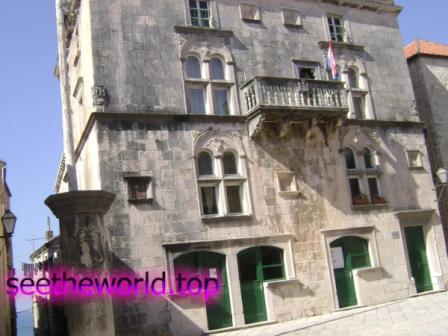
The Korcula City Museum is located in the Gabrielis Palace, which is a typical example of residential architecture of the Renaissance (XV-XVI centuries). The palace is located in the central square of the old town, decorated with a decorative stone facade, balconies and the coat of arms of the Gabrielis family. The opening of the city museum took place in 1957, and the exposition of those times has survived to this day with minor changes.
The exhibition halls of the museum introduce visitors to the cultural and economic life of Korčula from prehistoric times to the present day. The museum’s collections illustrate, first of all, the traditional crafts of the city: stone carving and shipbuilding as the most important for human life in this region. Household items, which were used by Korcula residents in the past , give an idea of the culture of local everyday life.
In the museum there is a copy of the ancient Statute (Charter) of the city and island of Korčula from 1214, a map of the city, city flags, seals and documents. In the archaeological hall you can see objects related to the prehistoric and medieval history of the island: Greek ceramics, amphorae, vases, Roman dishes, ship and construction accessories. The maritime history of Korčula is represented by beautiful watercolors by famous masters, navigational devices, nautical charts of the XVII-XIX centuries.
Franjo Tudjman Bridge
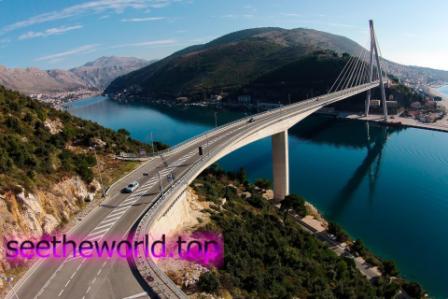
The Franjo Tudjman Bridge is the western gate of Dubrovnik and one of its modern buildings (built in 2002), which has become a landmark. This aerial suspension structure is suspended across Dubrovnik Bay and rests on cables (straight steel cables). The bridge has two 518-meter-long traffic lanes. The height of the bridge itself is no more than 150 meters, there are also road surveillance cameras.
The bridge has two names (due to political differences). In the world, it is better known as the Franjo Tudjman Bridge – named after the first president of Croatia. The second, less popular name sounds simple – Dubrovnik Bridge .
The city owes its popularity to the stunning view of the Adriatic Sea and the Old Town, which opens from its square. Both motorists and passengers of excursion buses passing from one part of the city to another can appreciate the view.
Today, the Franjo Tudjman Bridge is a symbol of Southern Dalmatia , which is often depicted on tourist brochures and postcards. Professional photographers and ordinary tourists who come to admire the turquoise waters of the Adriatic and the amazing view of Dubrovnik like to visit here .
Beaches of South Dalmatia
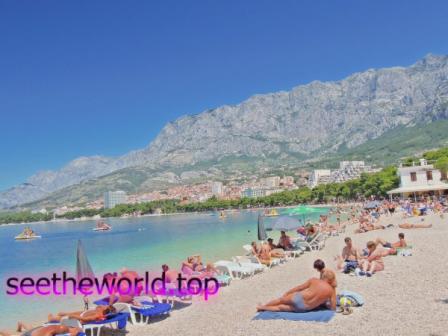
The closer to sunny Dubrovnik, the brighter the sensations, the more colorful the landscape, the hotter the air, and the warmer the sea.
Southern Dalmatia impresses with a variety of beach places: pebble beaches along the coast of resorts, small concrete platforms with special stairs in hotels, rocky beaches in isolated secluded places, and sandy beaches on the islands (Dubrovnik area).
In the legendary Dubrovnik, known not only for its sights, the beaches are mainly represented by concrete slabs and pebbles.
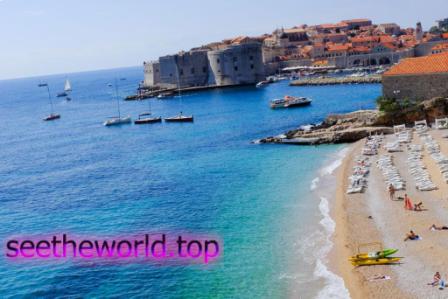
Among the most famous beaches in this resort is the crowded and noisy pebbly Banje Beach . It is located near the Old Town, which makes it even more attractive for inquisitive tourists who want to combine recreation by the water with educational pastimes.
The largest sand and pebble beach in Dubrovnik is Lapad Beach with excellent infrastructure.
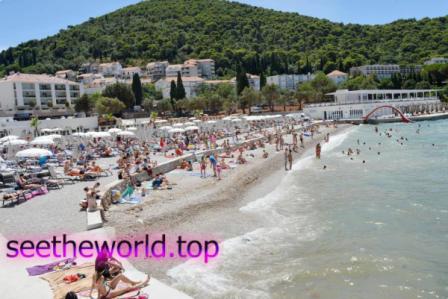
In the small village of Srebreno ( the town of Mlini , 10 km from Dubrovnik) there are small pebble beaches. There are areas with sand.
In addition to the resorts located on the coast of Southern Dalmatia, its main “beach” attractions include the islands of Korčula, Mljet, Koločep , which have many comfortably equipped sandy beaches. You can get to the islands only by sea from nearby resorts on the coast.
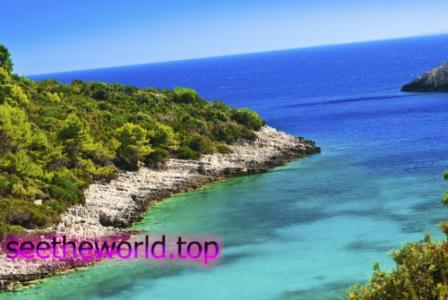
Rest on the island of Kolochep is characterized by leisure and peace. There are only two small villages here, the air is impeccably clean, and there is a sandy beach.
On the beautiful island of Korčula (homeland of the famous traveler Marco Polo), sandy beaches are located in calm, quiet bays.
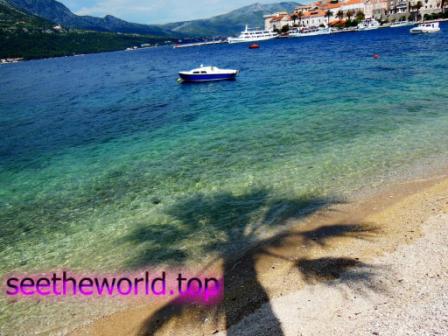
On the island of Mljet, in the idyllic village of Saplunara , there are sandy beaches that are rare in Croatia. The local beach with good access to the water is located in a sheltered semi-enclosed bay with picturesque coniferous trees, under the shade of which it is easy to hide from the sun.

The second sandy beach is located on the island in the protected town of Blace Bay .
What are the main differences of food in Croatia
- Diversity . This is explained by history, because Croatia was part of different countries, its ethnic composition changed, and new residents brought new recipes. Trade routes passed through the region, wealthy merchants and travelers lived here. For example, the famous Marco Polo came from the Croatian Korčula, from a family that was actively engaged in trade. It is also important that the Croats themselves have always been open to the unknown, so the dishes and recipes of other peoples and cultures got used, gradually transformed, adapted.
- Attention to details . People adopted other people’s culinary traditions, used new techniques to improve their own, experimented with spices, oils and herbs. Do you know where the most popular universal seasoning mix “Vegeta” was invented? Just half a century ago in Croatia through long trials and selections of combinations of tastes. The seasoning was liked not only by Croats and the people of all of Yugoslavia, but it made the company Podravka , which invented it, famous all over the world. And in Croatia, as well as in neighboring countries, soups are still cooked on the basis of this seasoning, salads are invented, meat is fried in it, and it is used for any stewed dish.
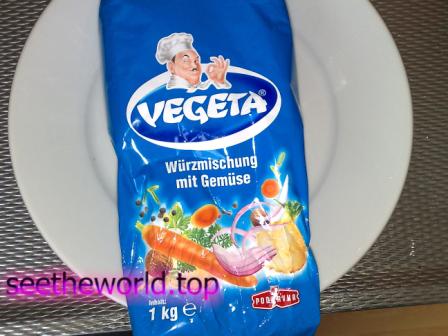
- Specialties tied to a geographic location . For example, we go to the island of Pag for the signature sage honey . The value of honey is that sage grows in conditions of a particularly favorable ecology and climate, where even drops of sea breeze falling on the leaves and flowers of the plant give additional healing properties to the future honey.
Different regions – different dishes and drinks
Most tourists make one mistake when they get to Croatia. Passing through different cities and regions, they eat the same dishes everywhere: some dare to try something local, most prefer something familiar from the menu. We do it differently: first we make a trip route, then based on it we make a list of signature dishes or drinks for which this or that place is famous. It is not only about original recipes, but also products that are used for cooking and grow only nearby. We add several cult institutions in this area to the same list.
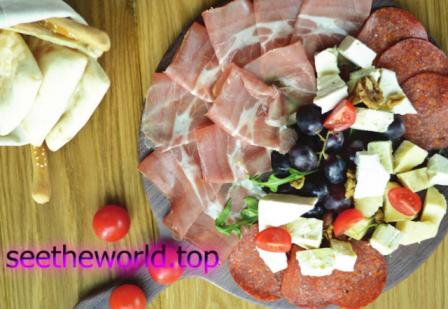
Southern Dalmatia and islands, Dubrovnik
Quick recipes are preferred here, something Italian and Greek is felt, herbs, figs, almonds are actively used in cooking, they make excellent olive oil themselves.
What should an experienced tourist try?
- The fresh fish and seafood prepared here are divine: sea bream, sea bass, sea bass, mackerel, octopus, cuttlefish, lobster, mussels and oysters.

- Prshut, the pride of local residents.

- Frogs, eels and crayfish (look in places where there is fresh water).
- Alcohol: wines “Grk”, “PRch”, “Dingach”, “Vugava”, “Plancich” and “Postup”, as well as the famous cherry liqueur “Maraschino” and herbal “Vlakhov” (some say that it is similar to “Balm of Riga”).
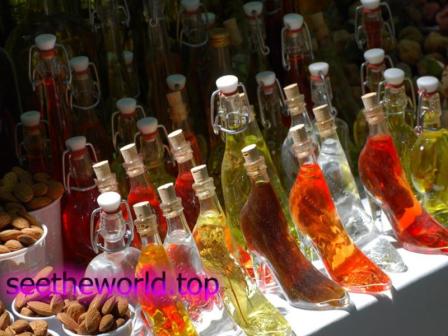
Many islands have their own, special dishes, which are included in the list of objects of national heritage and are definitely worth trying.
- Pashticada is a pork belly that is first marinated in vinegar or wine for a day, then cooked for several hours over low heat and served in a fragrant sauce with a side dish of pasta or gnocchi. This dish is available in all restaurants in South Dalmatia , but if you have the opportunity, go to the Pashticada festival in the village of Velika Brdo in the last days of September, when St. Jerome’s Day is celebrated here .

- Vitalats is a rare signature dish. It is prepared from the liver, heart and lungs of a dairy lamb, slowly roasted on a spit. The submission looks unusual. According to the idea, this is an appetizer that is served to guests while the lamb itself is roasted. There are special tours to the island of Brac , which include not only a hearty lunch, but also a master class on cooking vitalatsa.

- Visovachka begovitsa – marinated lamb with homemade aromatic herbs, vegetables and hard sheep’s cheese, which is best prepared on the island of Vis .

- Dalmatian-style Telbukh with cheese, vegetables and spices.
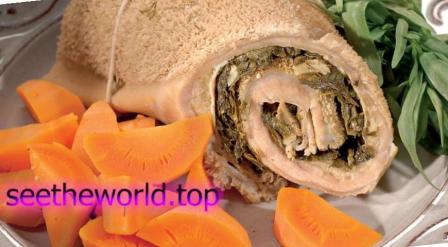
- Arambashichi is similar to stuffed cabbage, but in a leaf of sauerkraut made of various types of minced meat with seasonings.
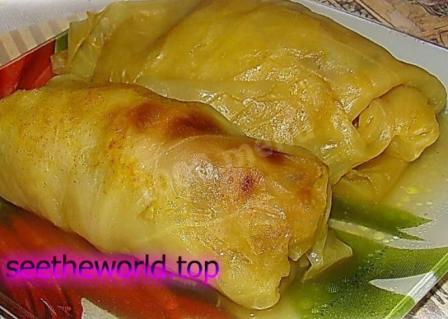
- Black risotto with cuttlefish
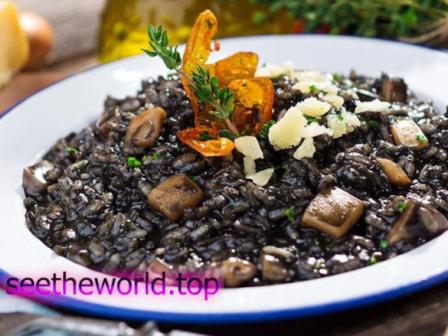
Sweets in Southern Dalmatia
If you look into the old cookbooks of Croatian grandmothers, you can find many amazing desserts made from the simplest ingredients that are always at hand. But what makes them special is the combination of flavors and cooking methods. For example, instead of a sponge cake, here the cheesecake can have a base of butter mixed with biscuit crumbs. High in calories, but more tender. Some of these recipes are still offered to invited guests, serving them with modern and refined delicacies.
- Bayadera is the signature dessert of Croatia. Nut praline with nougat and chocolate. The best bayadera in the form of candies (which are convenient to place in hand luggage) is made by the company “Krash”. The same cake can be ordered in any cafe, and at family holidays you can come across a cake of the same name, which is based on the same “bayadera” recipe. In terms of taste and consistency, candies differ from cakes. By the way, the “Krash” company has a large assortment of sweets and dozens of branded stores throughout the country, where you can buy sets of Croatian candies, chocolates, cookies and other confectionery products.
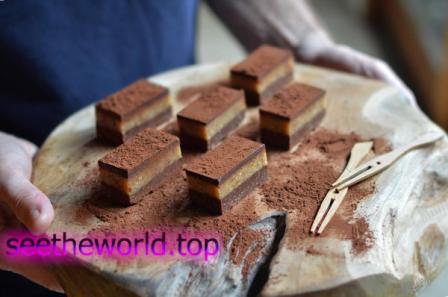
- “Paprenyake” is a cookie that has recently regained its former popularity. It is made according to the oldest recipe based on honey, nuts and pepper. Not bitter in the mouth, soft, sweet.

- “Chupavtsi” , as it turned out, turned out to be a copy of the famous Australian cake “Lamington” . And while some are puzzled as to how Croatian “chupavci” got to another continent, others cannot understand where cocoa and coconut come from in Croatia itself, because the recipe is considered relatively old. There is a version that one of the royal cooks once dropped a piece of sponge cake with chocolate glaze into a bag of coconut shavings. But he liked the result so much that he prepared a batch of cakes and invited the gentlemen to evaluate the idea. Now “chupavci” is one of the most popular desserts in Croatia.
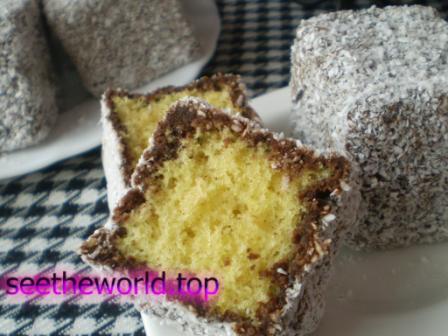
- “Rozhata” is served in many cafes. A delicate pudding dessert with caramel sauce and whipped cream. The best “births” are found on the island of Hvar and in Dubrovnik .
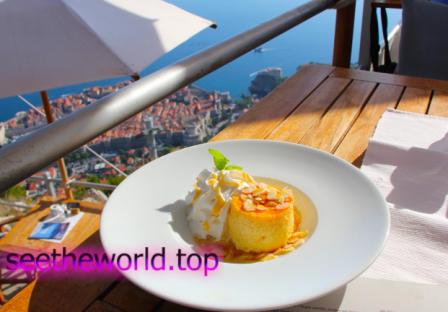
- “Schnenokle” looks like pieces of clouds under sauce. In fact, it is prepared like this: first, whites are whipped, boiled over low heat in milk, turning into delicate clots, and yolks, flour and milk are made into a light cream, which is then poured over the whites. Dessert is difficult to find in a cafe, but if you are invited as a guest, you can ask the hostess for a small favor in advance (it is very difficult to prepare it yourself without experience).

Food in restaurants
We would like to tell you about a couple of interesting things related to restaurant life in Croatia. As everywhere, going to a restaurant involves enjoying food and drinks in good company. But there are several features:
- Portions in South Dalmatia are large, and this should be taken into account when ordering. Take snacks at the rate of one snack per two people.
- If you are in a cafe with a view of the river or the sea, then you can sit at a table in the “first line” (tables that are closest to the body of water) only if you are going to have lunch, that is, you do not plan to just drink a glass of wine or a cup of coffee while looking at landscape. Therefore, when meeting guests at the entrance, the waiters clarify whether you are going to dine or not. In fact, there is a simple calculation behind this – lunch involves a higher bill than a regular coffee break, and waiters give better seats to those who spend more money. But if, in addition to coffee, you order something with alcohol and a dessert (or salad), then the place will be yours.
- When they eat soup, they tilt the plate towards themselves, and look into each other’s eyes while clucking. When they say a toast or clink, they don’t drain the glass to the bottom. They only take a sip.
- If the dish seemed tasty, try to finish it until the plate is clean. It will not offend the cook. It is enough to leave a good tip.
- Pay for your order by card, but bring small change for tipping. This way you will better control your expenses, and you will definitely not be charged by cunning waiters. Check your accounts!
- Be careful when ordering seafood dishes to avoid digestive problems. Order only bottled water (otherwise you may be given tap water, which many here consider safe to drink).
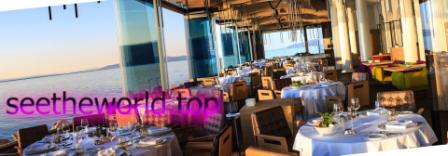
Street food and coffee tables on the streets
Any culinary fantasies of local street chefs should be tried only at large city festivals, where they are responsible for the quality of food. Or if you at least see what and how they cook for you. Exceptions are probably only bakeries, where there are many delicious pastries. In the fall, you can catch street vendors selling roasted chestnuts. We do not recommend trying pleskavitsa and chevap on the street, as well as fish. We recommend buying Cedevita sparkling water with vitamins at any kiosk (children love it). This is another product that many people bring with them from Croatia (it is sold in the form of a regular powder, which can then be diluted with water).
